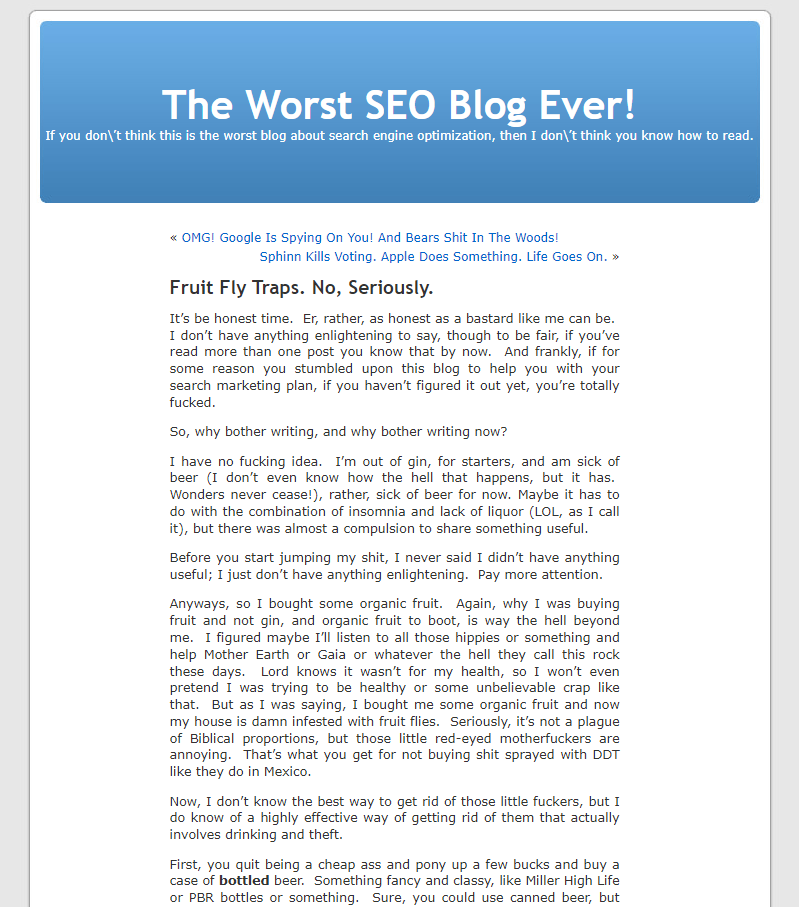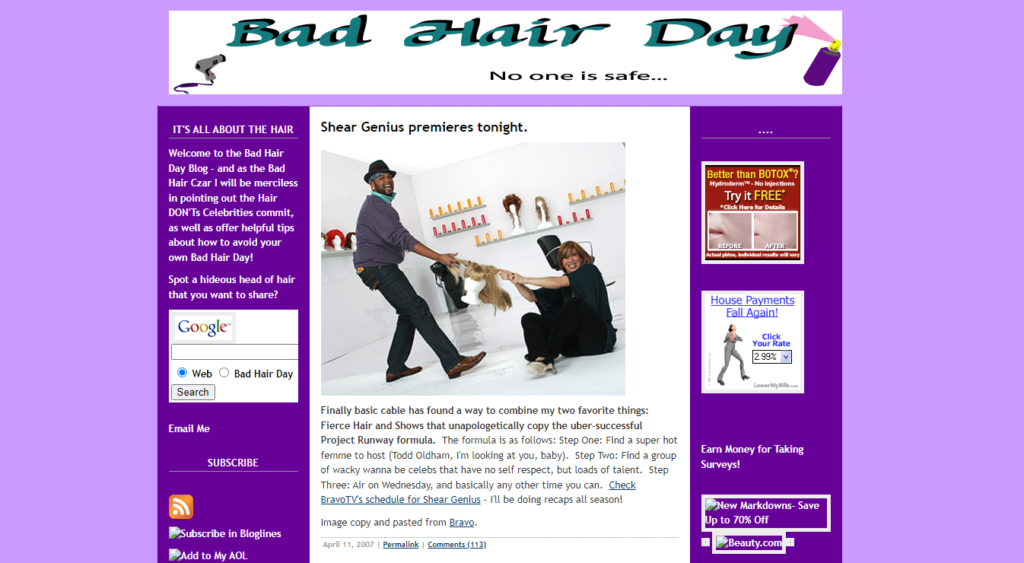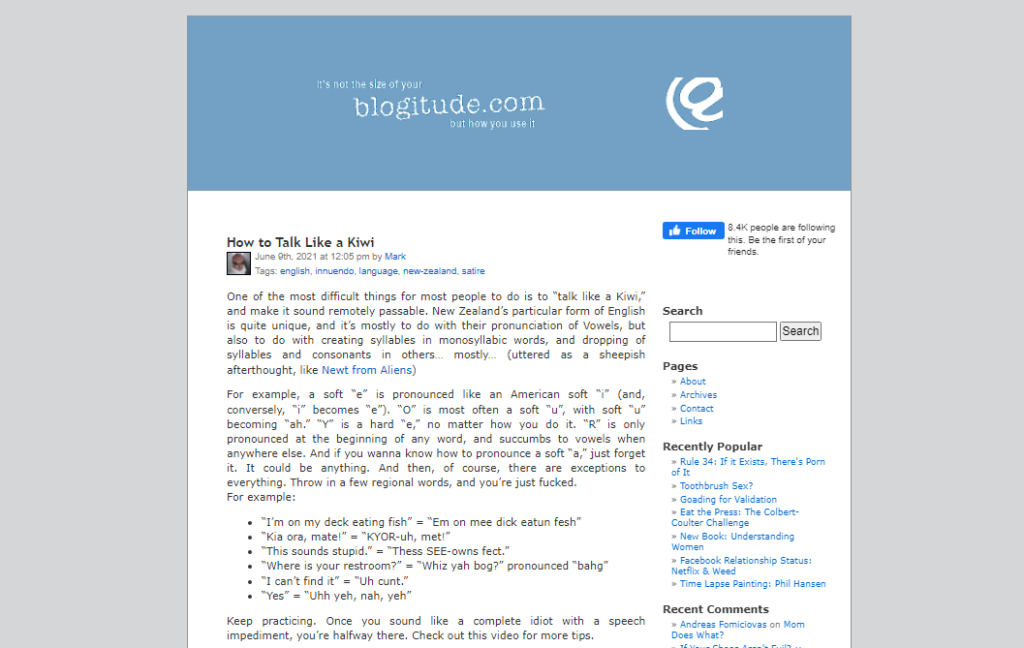[Do you like this? Please subscribe to my YouTube Channel and then share it for me!]
Video Summary
I want to help you get your business showing in the search results, and you need to know that posting to your business blog is a very good way to do that.
It turns out that blogs are a perfect channel to provide relevant content for your visitors. And that content helps keep them on your website and coming back for more. Investing in your own blog and creating content related to your business not only establishes your authority in your industry, but also connects you to your target audience.
But not all blogs make visitors want to read more. The reality is there are many blog posts that practically force readers to close the page or hit the back button.
I’m going to share with you some examples, so you can avoid these things…
Video Transcript
Hey, this is Jeffrey Kirk and today I’m going to show you some examples of bad blog posts! Before I dig in, be sure to subscribe to my channel and turn on the notifications so you don’t miss my next video that’s coming out soon.
Why Do I Want To Show You Bad Blog Posts?
So you do better!
I want to help you get your business showing in the search results, and you need to know that posting to your business blog is a very good way to do that. In fact, according to general blogging statistics, in 2022 more than 409 million people view blog posts every month.
So, if your business blog posts appear near the top of the search results, you can tap into that very large traffic stream. And what’s the best way to create online visibility while connecting and engaging with your audience?
Blogging
Of course, the answer is blogging! I realize that writing and publishing blog posts is not likely something you look forward to in your business. But the fact that you’re here today tells me you’re at least thinking about it.
It turns out that blogs are a perfect channel to provide relevant content for your visitors. And that content helps keep them on your website and coming back for more. Investing in your own blog and creating content related to your business not only establishes your authority in your industry, but also connects you to your target audience.
But not all blogs make visitors want to read more. The reality is there are many blog posts that practically force readers to close the page or hit the back button. I’m going to share with you some examples, so you can avoid these things…
Examples of Bad Blogs
But first, let me point out that I know nothing about these blogs or their original intent. For all I know, they were created to be bad examples of blog posts. The only reason some of these are still around is probably because they get traffic as being bad examples.
But since you have a business, I throw these up as a warning. Do not do these things! Alright, now I’m going to go to my computer so I can show you the examples.
1. Misleading URL
All right, the first example I have is here at HubPages. So the problem we’re looking at is, in this case, the URL says 10 examples of a bad blog. If we were at the search engine and we saw this, we’d be thinking we’d come to this page and see 10 examples, but in reality, we’ve just got five examples of a bad blog.
And we can scroll down and see that that’s true. There are five examples. So it’s somewhat misleading. If you were at the search engine, you did a search, you saw it said 10 examples of a bad blog and you clicked, wouldn’t you be expecting 10 to get here and see only five?
There’s a mismatch. We don’t want that. In your blog posts, you need to remember accuracy is beneficial. It’s useful for the searchers because it gives them what they’re expecting and it’s useful for the search engines as well, because it helps tell them, with the title and the URL, what that page is actually about, which helps it get indexed properly.
Plus, for your visitors, if they remember the name, it’s easier for them to come back later by doing a search. If the name is wrong, they’re not going to get what they were looking for.
2. Doesn’t Offer Any Value
The next one I have for you is a blog post that doesn’t really offer any value. So you’ve got to keep in mind the purpose of the blog. Part of that is to connect with your audience and help them solve their problems. If there’s no connection between your content and the solution that they’re looking for, then there really isn’t a purpose for your business.
Now, this one, the blog is actually called The dullest blog in the world because it is intended to show low value. The posts are just… it’s just random stuff expressed in a few sentences. So this one isn’t designed to be a business blog. But for your business, you need to provide posts that show real value, and a sentence or two doesn’t cover that.
You want to consider 300 words the minimum of any blog post. 500 words is better and there’s nothing wrong with going longer than that, and that’s because great content provides value to your audience, and in turn, they’re more likely to connect with your business and eventually make that purchase.
Plus, the more content you have on a page, the easier it is for search engines to figure out the meaning of that page, and that way they can index it properly. So if you want people to find your business, give them good content and help them solve their problems.
And also, in the previous example, I showed you a mismatch of the URL, well take a look at this one. This page is called P equals 92. That is a default WordPress blog configuration. It’s totally useless. So you want to make sure that your site is configured properly so that the URL is more like this one where it shows a name and a title, and ideally, as I mentioned, those two should match, but at least this one has some text here. This one is just stupid.
3. Overuse of Big Blocks of Text
All right, let’s move on to the third example. All right, here we are at The Worst SEO Blog Ever. Now, this example that I have is the overuse of big blocks of text. So have you ever gone up against a webpage like this where it’s just text, following text, following text, and a huge paragraph like this one?
That’s just crazy. People don’t like seeing big blocks of text. Their eyes glaze over and they think, “Well, who wants to read all this stuff?” So you want your post to be inviting. You don’t want it to look like it’s some kind of legal agreement that someone has to get to the end and then sign it.
That’s not what you want at all. And the reason for that is, according to statistics, 43% of people just skim blog posts. So if your posts are made up of mostly text blocks like this one with very few breaks in it, you can pretty much say goodbye to anybody who you want to be on your site.
You need to keep your posts and your content easy to read. That’s going to help keep people around. Add images, add graphics, add lists or bullets, and use some headers to break up those wordy parts. So great content that’s easy on the eyes and it’s easily understood. This is not.
When you have content that is clear, it has valuable information, it’s easy to read, it’s easy to look at, that just helps your readers stay around longer, and when that happens, they’re spending more time with you. They’re building that relationship with you and your business through your website and through your blog. All right, next example, bad Hair Day. This is a website layout example.
4. Poor Website Layout
This site, it’s kind of old here, April 11th, 2007. So that’s really old. It’s more than 15 years old at this point in time. And that’s part of the point here. If you haven’t updated your website in the last 10 years or more, it’s probably time to do that. But just as importantly, remember that people like looking at things that look good, things that appeal to them, that have a pleasant design.
So if your website still looks like it was developed in the 1990s, then it’s not likely that people are going to want to stay around and read. Website credibility is important for you to attract new clients. And if people are arriving at your website for the very first time and they have no idea about your business, what they see here is going to form that first impression.
You want to introduce your brand and instill a sense of trust for them. If they get to your site and they don’t know where to click or where to find whatever it is they’re looking for, they’re going to leave and they will never, ever come back. So I know I hear it from time to time, “Well, my neighbor’s 12 year old kid, he’s a genius and he can design our site for $25.” It’s like, come on, really?
If you end up with a site and it has a header like this, you can just kiss business goodbye. You’re going to get about as much business from your website as you are willing to pay for that design. If your site doesn’t look professional, prospects are going to question your business, and they might think, “If you can’t put up a good website, are you really going to be able to take care of my needs?”
You’ve got to remember that your website layout reflects your brand’s image, and when it’s set up properly, your website is an asset. It works for you 24 hours every day. It’s worth giving your website some love. And the other thing that this website is a good example of is not updating your blog regularly, in this case, as I already mentioned, April 11th of 2007. Somebody has probably had a bad hair day since 2007, right?
So in this case, we don’t know if the blog creators are even around anymore. This website might just be sitting out there and there is no one taking care of it. If it’s a business website, what happens then? You don’t want someone arriving at your site only to wonder if you’re still in business.
5. No Consistency
And that leads me to my last example for today. Again, not a really great design here, and what we need to look at is the most recent post was in June of 2021, and the one before that is January of 2019, and prior to that, we had September of 2017. This is a problem I see all the time with business websites, and heck, I’ve been guilty of it myself, and that is there’s no consistency.
How is someone going to be able to trust your business if you can’t be consistent?
So you might have good intentions, you start posting good content, and then something happens, some bigger priority comes up, it takes your attention away, and then you lose that consistency. But then your site gets old and people don’t know if you’re still around. And search engines don’t know if they should continue even showing your business in the search results. And that’s critical.
Once you get out of the habit, it becomes difficult to get started again. The reality is that search engines love new and updated content, and that means the more you post, the more likely your content starts to rank higher in the search results. And regularly adding content to your website also shows that your site is active and up to date, and that contributes to your credibility and your trustworthiness.
On the other hand, if you’re like this and you only publish something once every year or every other year, people start to wonder if your business is legitimate or not. And the search engines don’t know either. So consider what happens if you stop updating your website while a competitor continues to post every week, or even every other month.
Which business will a search engine assume is still around? Of course, it’s the one that is still posting content. I hope these examples help you. Of course, there are many other things you could do wrong or do poorly.
Bottomline
Some things to watch out for are useless or deceptive headings, having posts that are full of ads, publishing content with typos and spelling errors, and font sizes that are too small or with colors that are difficult to read. Instead, reward those who make it to your site with good information that’s easy to follow, and you’ll be rewarded in return.
Achieving a perfect blog is not easy. And perhaps there is no such thing as the perfect blog or the perfect website for that matter. But you don’t need perfection, not even close! Just pick a publishing schedule. Decide what you can do regularly and stick to it. It doesn’t matter if it’s daily, weekly, monthly, or even quarterly.
Of course more often is better than less often, but I would rather see you stick to a schedule of one blog post every month like clockwork than deciding to do it weekly and succeeding for a little while and then having to stop. Consistency is important.
Alright, be sure to like this video, and please post in the comments telling me about a really bad blog post that you have found. Be sure to add the link. I would love to compile a fresh list of what not to do on a blog!
Your business deserves to be seen online, and I will help you get there.
Thanks for watching and have a great day!




